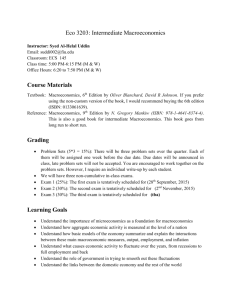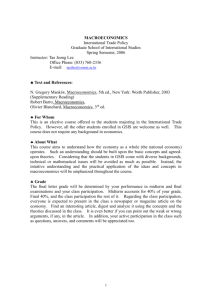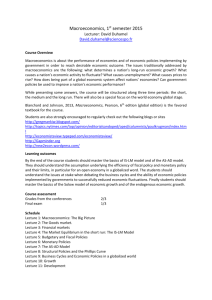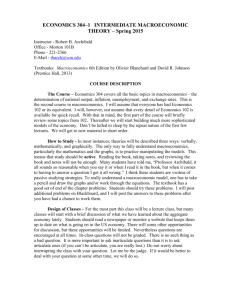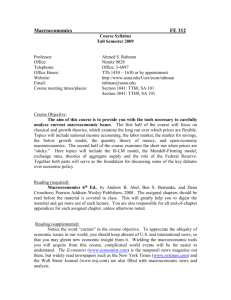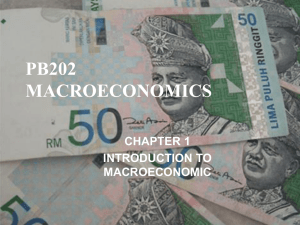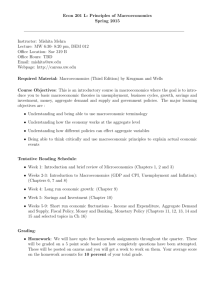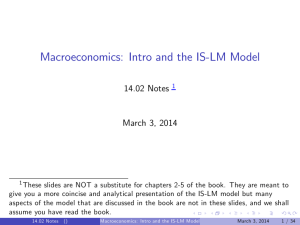UNIVERSIDAD DE HUELVA FACULTAD DE CIENCIAS
advertisement
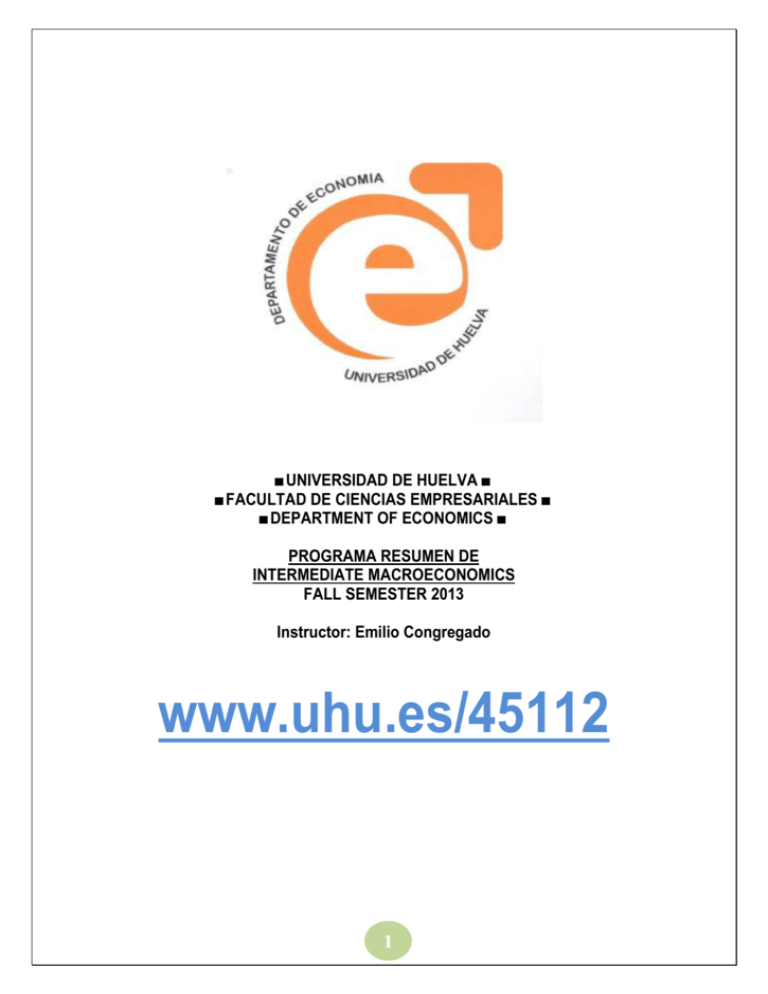
■UNIVERSIDAD DE HUELVA ■ ■FACULTAD DE CIENCIAS EMPRESARIALES ■ ■DEPARTMENT OF ECONOMICS ■ PROGRAMA RESUMEN DE INTERMEDIATE MACROECONOMICS FALL SEMESTER 2013 Instructor: Emilio Congregado www.uhu.es/45112 1 Course design: A course in macroeconomics at the intermediate level builds upon the foundations that should have been established in an introductory course of Macroeconomics. The topics will be familiar: Fiscal and monetary policies, interest rates, inflation, Unemployment rates, business cycles, economic growth, central banks, public and pxternal debt, ..., but the analysis will be undertaken with significantly more rigor and sophistication tan in an introductory course. There will be particular emphasis on the use of economic models to assist in our understanding of various economic linkages. In addition, there will be a significant section of the course devoted to an introduction to computational economics, about how solve macroeconomic problems using Excel, in order to test empirically some of the theoretical relationships and in order to introduce simulation models. COURSE OUTLINE (TENTATIVE) 1.- INTRODUCTION 1.1.- A refresher of principles of macroeconomics 1.2.- The key macroeconomic problems 1.3.- The current crisis PART I: OPEN ECONOMIES WITH FLEXIBLE PRICES 2.- IS-LM MODEL IN OPEN ECONOMIES 2.1.- Basic Keynesian model 2.2.- Monetary market 2.3.- IS-LM in open economies without capital flows 3.- MUNDELL-FLEMING MODEL 3.1.- Exchange rates 3.2.- Mundell-Fleming Model 3.3.- Economic Policies PART II: FLEXIBLE PRICES 4.- AGGREGATE DEMAND 4.1.- From IS-LM model to AD 4.2.- The algebra 4.3.- Demand policies 5.- THE AGGREGATE SUPPLY 5.1- Inflation, expected inflation and unemployment rate. 5.2.- Philips relationship 5.3.- The aggregate supply 5.4.- Supply policies 5.5.- The AD-AS scheme 5.6.- Supply vs. demand policies 6.- The AS-AD DYNAMIC SCHEME 6.1.- The DAS 6.2.- The DAD 6.3.- The dynamic scheme in action 7.- MACROECONOMIC POLICY 7.1.- Short vs, long run impacts 7.2.- Rules vs discretion. PART III: ECONOMIC GROWTH AND BUSINESS CYCLES 8. MODELOS DE CRECIMIENTO 8.1. Stylized facts 8.2.- Solow-Swan Model 8.3.- Growth Accounting and the Solow residual 8.4.- Endogenous growth 8.5.-Growth Empirics: the convergence hypothesis 9.- BUSINESS FLUCTUATIONS 9.1.- Business Cycles 9.2.- Co-movement 9.3.- Persistence 9.4.- Stabilization Policies PARTE IV: MACROECONOMICS IN RETROSPECTIVE 10.1.- The Classical view 10.2.- Marginal revolution 10.3.- Keynesian revolution 10.4.- Neoclassical synthesis 10.5.- Current trends REFERENCES Textbooks o o o Blanchard, O. (2012) Macroeconomics, 5th edition, Pearson Mankiw, N.G. (2012) Macroeconomics, 7h edition, Worth Publishers Other readings will be e-mailed, or placed in the Moodle. SCHEDULE 2 Class time Mondays, 14:00-15:30 Dates (EXAMS) MIDTERM EXAM: November 11, 2013 (14:00 h) FINAL EXAM: TBA (To be agreed) INSTRUCTOR Emilio Congregado Associate Professor of Economics E-mail: congregado@uhu.es Phone: +34 959217832 (office) Web: www.uhu.es/emilio.congregado Twitter: @econgregado OFFICE 54 (Faculty of Business Administration, 2nd floor) OFFICE HOURS (OR BY APPOINMENT) FALL SEMESTER Lunes Martes 10:45-13:30 Miércoles Jueves 10:45-13:30 Viernes Methodology The course represents an introduction to models that are typical of intermediate macroeconomics. Students are expected to attend classes and participate, both passively (taking notes, listening) and actively (trying to work ahead of time, asking questions, solving exercises, thinking about the possible implications and the possible extensions). Organizational Aspects Lecture notes for each topic will be uploaded on the webpage and moodle before the beginning of a class. Problem sets will also be uploaded on ADI. Students should make their best effort and work on every problema set after any practical session. Group work is encouraged for both revising key theoretical concepts and for interpreting and solving exercises. Time Distribution As for any course attributing 6 ECTS credits, students’ workload is expected to be of about 150 hours. An indicative distribution of this preparation time is as follows: Lectures: students will take notes and use material made available through ADI Practical sessions: students will follow (and participate to) the solution of problem sets, additional exercises and questions 3 Personal and team work: study, solving problem sets, asking questions in the office hours Evaluation Exams: There will be two exams (each covering approximately a half of the material), comprised of essay questions and detailed analytical problems. The exams will test: 1) your understanding of economic theory and models, and how policy changes work within the context of those models to affect various sectors of the economy, 2) your ability to apply the theory to the analysis of current economic events. The exams collectively represent 65% of your grade. Practice Problems: You also have some practice problem set. They will be located in the Moodle. The questions follow closely the sequence of material as it is presented in class. These practice problems, for the most part, take the place of routine homework. As an incentive for you to work through these problems, I am offering you a total of 30%of your grade. The points will be added to your end of semester final grade point average. Attendance and class participation: Good attendance and involvement in class discussions are easy ways to pick up your 5% Class Participation points. Grade summary: o o o o Exams 65% (30% midterm and 35% final exam) Practice Assignments 30% Class participation 5% Total 100% Grading scale: 90-100:A, B, 60-90: C, 50-60: D, <50 Expected abilities (Theoretical Knowledge) • • • • • • • • • IS-LM model in open economies Aggregate Demand (AD) models Aggregate Supply (AS) models Interaction AD-AS Dynamic AD-AS model Theories about growth: evidence Business cycles: determinants Evaluation, of the relevant macroeconomic events Appropriate analysis of current events 4
